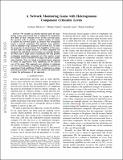A Network Monitoring Game with Heterogeneous Component Criticality Levels
Author(s)
Milosevic, Jezdimir; Dahan, Mathieu; Amin, Saurabh; Sandberg, Henrik
DownloadSubmitted version (513.4Kb)
Open Access Policy
Open Access Policy
Creative Commons Attribution-Noncommercial-Share Alike
Terms of use
Metadata
Show full item recordAbstract
We consider an attacker-operator game for monitoring a large-scale network that is comprised of components that differ in their criticality levels. In this zero-sum game, the operator seeks to position a limited number of sensors to monitor the network against the attacker who strategically targets a network component. The operator (resp. attacker) seeks to minimize (resp. maximize) the network loss. To study the properties of mixed-strategy Nash Equilibria of this game, we first study two simple instances: When component sets monitored from individual sensor locations are mutually disjoint; When only a single sensor is positioned, but with possibly overlapping monitoring component sets. Our analysis reveals new insights on how criticality levels impact the players equilibrium strategies. Next, we extend a previously developed approach to obtain an approximate Nash equilibrium in the general case. This approach uses solutions to minimum set cover and maximum set packing problems to construct an approximate Nash equilibrium. Finally, we implement a column generation procedure to improve this solution and numerically evaluate the performance of our approach.
Date issued
2019Department
Massachusetts Institute of Technology. Center for Computational Engineering; Massachusetts Institute of Technology. Department of Civil and Environmental Engineering; Massachusetts Institute of Technology. Institute for Data, Systems, and SocietyJournal
Proceedings of the IEEE Conference on Decision and Control
Publisher
Institute of Electrical and Electronics Engineers (IEEE)
Citation
J. Milošević, M. Dahan, S. Amin and H. Sandberg, "A Network Monitoring Game with Heterogeneous Component Criticality Levels," 2019 IEEE 58th Conference on Decision and Control (CDC), 2019, pp. 4379-4384
Version: Original manuscript
ISSN
2576-2370